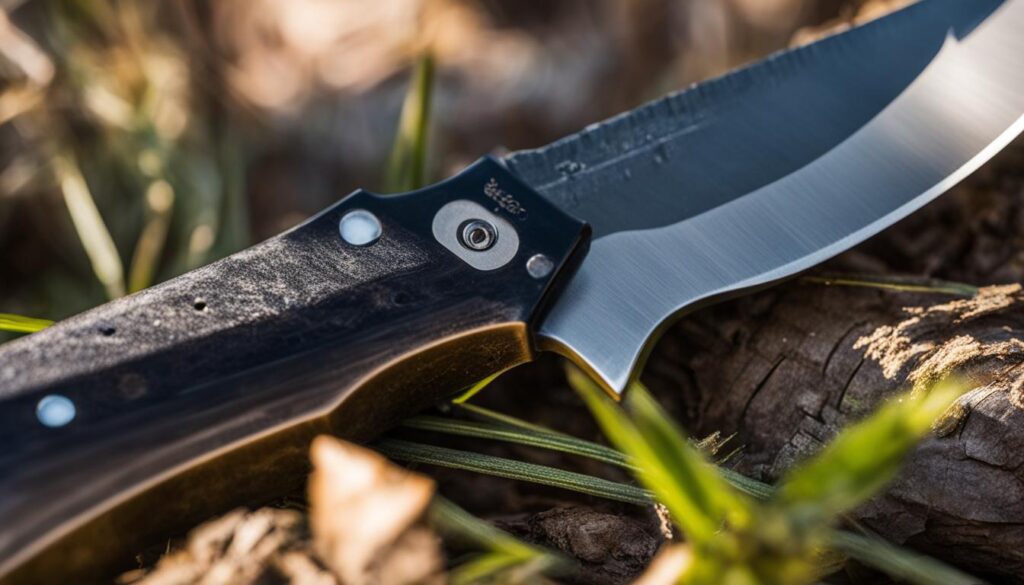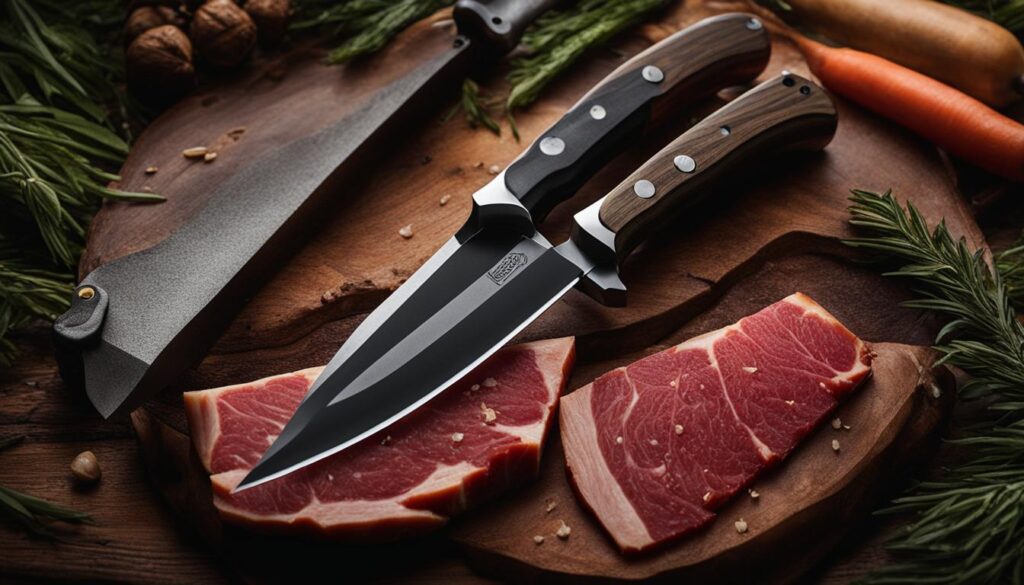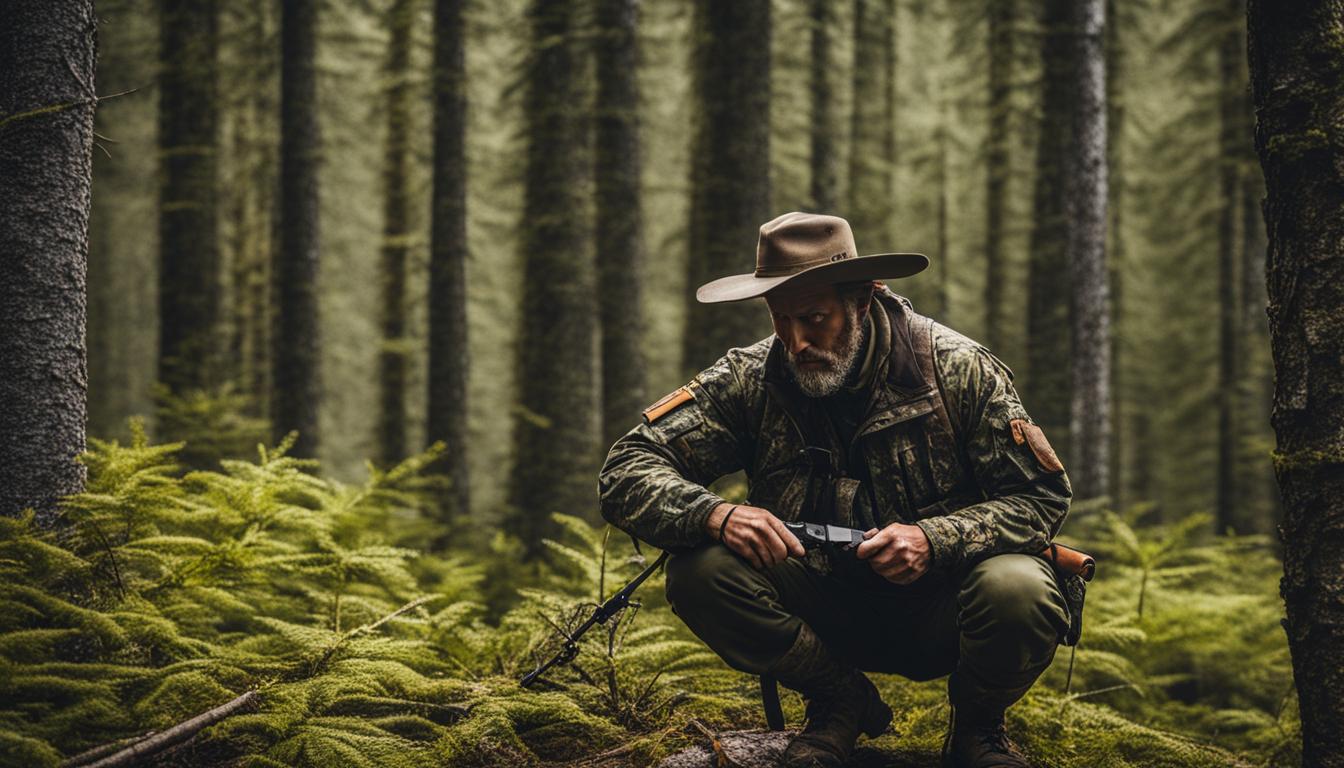When it comes to hunting, ensuring safe practices and promoting hunter safety is of utmost importance. One key aspect of this is choosing the right hunting knife. A high-quality hunting knife not only increases the chances of a successful hunt but also plays a crucial role in ensuring the safety of the hunter. There are several factors to consider when selecting a hunting knife, including the blade material, blade style, handle material, blade length, and sheath options. By carefully considering these factors, hunters can make an informed decision and enhance their overall hunting experience.
Key Takeaways:
- Ensuring safe hunting practices and promoting hunter safety are crucial in the hunting community.
- Choosing the right hunting knife is essential for both safety and success during hunts.
- Factors to consider when selecting a hunting knife include blade material, blade style, handle material, blade length, and sheath options.
- Investing in a high-quality hunting knife increases the chances of a successful hunt and promotes safe hunting practices.
- By considering individual preferences and specific hunting needs, hunters can find the perfect hunting knife that ensures their safety.
Blade Material: Stainless Steel vs High-Carbon Steel
When it comes to choosing a hunting knife, one of the most important factors to consider is the blade material. The blade material not only affects the performance and durability of the knife but also determines its suitability for different hunting environments. Two common blade materials used in hunting knives are stainless steel and high-carbon steel.
Stainless steel blades are known for their exceptional corrosion resistance. This makes them an excellent choice for hunters who often find themselves in wet or humid conditions. Stainless steel blades are less prone to rust and require minimal maintenance. They are also more resistant to staining, which can be especially beneficial when field dressing game. However, it’s important to note that stainless steel blades may be slightly less sharp than high-carbon steel blades.
High-carbon steel blades are renowned for their superior edge retention. They are extremely durable and can maintain a sharp edge for extended periods of heavy use. High-carbon steel blades are ideal for tasks that require precision cutting, such as skinning game. However, they are more susceptible to corrosion and require regular maintenance to prevent rust. Hunters who prioritize sharpness and precision may prefer high-carbon steel blades.
Ultimately, the choice between stainless steel and high-carbon steel blades depends on the specific hunting environment and the hunter’s preferences. Consider factors such as corrosion resistance, edge retention, and maintenance requirements when selecting the blade material for your hunting knife.
| Blade Material | Corrosion Resistance | Edge Retention |
|---|---|---|
| Stainless Steel | High | Moderate |
| High-Carbon Steel | Moderate | High |
Blade Style: Drop Point, Clip Point, Gut Hook
When it comes to selecting a hunting knife, the blade style is a crucial consideration. The choice of blade style depends on the specific tasks the hunter will be performing during their hunts. Hunting knives come in various blade styles, each suited for specific applications such as skinning, caping, and field dressing.
The drop point blade is a popular choice among hunters due to its versatile curved spine. This blade style is ideal for tasks that require precision slicing and skinning, as the curved edge allows for easy maneuverability and control. Its broad blade shape also provides added strength and durability, making it suitable for heavier cutting tasks.
The clip point blade, on the other hand, features a sharper point and a more defined belly. This blade style excels in tasks that require precision cutting, such as caping and detail work. The sharp point enables hunters to make intricate cuts with ease, while the belly of the blade allows for efficient skinning and general-purpose cutting.
Some hunting knives also incorporate a gut hook on the spine of the blade. This specialized feature is designed for field dressing game without puncturing internal organs. The gut hook provides a safe and efficient way to open the abdominal cavity, allowing hunters to easily remove the entrails while minimizing the risk of accidental punctures.
Comparison of Blade Styles
| Blade Style | Use | Advantages |
|---|---|---|
| Drop Point | Skinning, slicing, general-purpose cutting | Versatile, easy to control, durable |
| Clip Point | Detail cutting, caping, skinning | Precision cutting, sharp point, efficient skinning |
| Gut Hook | Field dressing, opening abdominal cavity | Safe, efficient, minimizes accidental punctures |
Choosing the right blade style depends on the type of hunting the individual will be engaged in and the specific tasks they will need to perform. Consideration should be given to the type of game being hunted, the desired level of precision, and the overall versatility required from the hunting knife.
Handle Material: Wood, Rubber, Synthetic Materials
When it comes to choosing a hunting knife, the handle material is just as important as the blade. The handle should provide a comfortable grip and superior durability, ensuring that hunters have full control of their knife even in challenging conditions.
One popular option for hunting knife handles is wood. Wood handles not only provide a classic and aesthetic appeal, but they also offer a natural grip that feels comfortable in the hand. However, it’s important to note that wood handles may require more maintenance to prevent warping or cracking.
For those looking for optimal grip and durability, rubber and synthetic materials are excellent choices. Rubber handles offer a secure grip, even in wet or cold conditions, making them suitable for hunting in various environments. Synthetic materials like G10 and Micarta are known for their superior durability and resistance to moisture and heat. These handles provide a reliable grip and are less likely to warp or crack over time.
Wood Handle
Wood handles are favored for their natural and classic look. They provide a comfortable grip and typically have a smooth finish. However, it’s important to choose a wood species that is known for its durability, such as walnut or stabilized wood.
Rubber Handle
Rubber handles are designed to provide a superior grip, even in wet or slippery conditions. The textured surface of rubber handles ensures that hunters can maintain control of their knife, reducing the risk of accidents or injuries.
Synthetic Handle
Synthetic handles, such as those made from G10 or Micarta, offer both comfort and durability. These materials are resistant to moisture and heat, making them ideal for hunting in various environments. Synthetic handles also come in a range of colors and patterns, allowing hunters to choose a style that suits their personal preference.
| Handle Material | Comfortable Grip | Superior Durability |
|---|---|---|
| Wood | ✓ | ✓ |
| Rubber | ✓ | ✓ |
| Synthetic | ✓ | ✓ |
Blade Length: Finding the Ideal Length
When it comes to choosing a hunting knife, blade length is a crucial factor that hunters must consider. The right blade length can make a significant difference in the performance and versatility of the knife during different hunting tasks. Whether it’s general-purpose hunting or specific tasks like skinning or field dressing, understanding the benefits of longer and shorter blades can help hunters make an informed decision.
General-Purpose Hunting:
For general-purpose hunting, a blade length between 3 to 5 inches is often recommended. This range provides a good balance between maneuverability and functionality. A blade that is too short may limit the knife’s cutting capacity, while a blade that is too long can be cumbersome and difficult to control during intricate tasks.
Versatility:
Shorter blades offer more versatility as they are easier to control and maneuver in tight spaces. These blades are particularly suitable for tasks that require precision and fine detail work, such as caping or field dressing small game. Additionally, shorter blades are more convenient for everyday carry and can be easily stored in a backpack or hunting gear.
Longer Blades:
On the other hand, longer blades are better suited for larger game and tasks that require more cutting power. A longer blade allows hunters to make deeper cuts and provides better leverage for tasks like skinning or quartering game. However, it’s important to note that longer blades may be less maneuverable in tight spaces and may require more skill and control to use effectively.

Sheath and Carry Options: Safe Storage and Easy Access
When it comes to choosing a hunting knife, the sheath and carry options are often overlooked but play a vital role in ensuring safe storage and easy access. A good sheath allows for secure and convenient carrying, whether on a belt or in a pack. Let’s explore the different sheath and carry options available for hunting knives.
Belt Carry
Belt carry is a popular choice for hunters who want quick and easy access to their knife. A sheath designed for belt carry attaches securely to the hunter’s belt, providing a reliable and readily accessible storage solution. This option allows hunters to keep their knife within arm’s reach at all times, ensuring they can respond swiftly to any situation that may arise during their hunt.
Pack Carry
For hunters who prefer to keep their hands free or carry multiple tools and equipment, pack carry is an excellent choice. Sheaths designed for pack carry typically feature mounting options that allow them to be easily attached to backpacks or gear bags. This option ensures that the knife remains secure and easily accessible while the hunter focuses on other tasks or navigates through challenging terrain.
| Sheath and Carry Options | Description |
|---|---|
| Belt Carry | A sheath attached to the hunter’s belt, providing quick and easy access to the knife. |
| Pack Carry | A sheath designed for attachment to backpacks or gear bags, allowing for hands-free carrying and easy access. |
By considering the sheath and carry options when choosing a hunting knife, hunters can ensure that their knife is stored safely and easily accessible whenever it is needed. Whether opting for belt carry or pack carry, selecting the right sheath is crucial for a successful and enjoyable hunting experience. Improper storage or difficult access to a hunting knife can not only impede a hunter’s ability to respond quickly but can also pose a safety risk. Take the time to choose the sheath and carry option that best suits your needs and preferences, and enjoy the peace of mind that comes with knowing you have a reliable and accessible tool by your side on your hunting adventures.
Pros and Cons of Fixed Blade vs Folding Knives
When it comes to choosing a hunting knife, one important decision to make is whether to go with a fixed blade or a folding knife. Both options have their own set of pros and cons, and the choice ultimately depends on the hunter’s preferences and specific needs.
Fixed Blade Hunting Knife
A fixed blade hunting knife is a heavy-duty tool that offers durability and strength. It consists of a solid blade that does not fold, providing stability during tough tasks. One of the key advantages of a fixed blade knife is its reliability, as there are no moving parts that can break or malfunction. This makes it a popular choice among hunters who require a knife that can handle heavy-duty tasks such as field dressing and processing game.
Additionally, fixed blade knives are often easier to clean compared to folding knives since they do not have hinges or crevices where dirt and debris can accumulate. This makes them a hygienic choice, especially when dealing with game meat. However, due to their larger size and lack of folding mechanism, fixed blade knives can be less convenient to carry and store.
Folding Hunting Knife
Folding knives are known for their convenience and portability. They feature a blade that can be folded into the handle, making them compact and easy to carry. One of the key advantages of a folding hunting knife is its safety. Most folding knives have locking mechanisms that keep the blade securely in place when open, reducing the risk of accidental injuries.
Furthermore, folding knives are versatile tools that can be used for various tasks. They are practical for everyday carry and can be used for tasks beyond hunting, such as camping or outdoor activities. However, folding knives may not be as durable as fixed blade knives, as the hinges and locking mechanisms can wear out or become damaged over time.
Table: Pros and Cons of Fixed Blade vs Folding Knives
| Pros | Fixed Blade Hunting Knife | Folding Hunting Knife |
|---|---|---|
| Heavy-duty | ✓ | |
| Safe | ✓ | |
| Convenient | ✓ | |
| Easy to clean | ✓ |
Ultimately, the choice between a fixed blade and a folding knife comes down to personal preference and the specific needs of the hunter. Each type of knife has its own advantages and disadvantages, and hunters should consider factors such as durability, safety, convenience, and ease of cleaning when making their decision. By carefully weighing these factors, hunters can select a knife that best suits their hunting style and requirements.


Conclusion
Choosing the right hunting knife is a decision that should not be taken lightly. A quality hunting knife is essential for both the safety and success of a hunt. By considering factors such as blade material, blade style, handle material, blade length, and sheath options, hunters can ensure the selection of the right hunting knife for their needs.
Investing in a high-quality hunting knife is crucial for promoting safe hunting practices. The blade material should be chosen based on the specific hunting environment, whether it’s stainless steel for corrosion resistance or high-carbon steel for excellent edge retention. The blade style should match the tasks the hunter will be performing, whether it’s skinning, caping, or field dressing. The handle material should provide a comfortable and secure grip, even in challenging conditions.
Blade length is another important consideration, with longer blades being better suited for larger game and shorter blades offering more versatility. The sheath and carry options should allow for safe storage and easy access, whether it’s belt carry or pack carry. Lastly, the choice between a fixed blade and a folding knife depends on the hunter’s preferences and needs, with fixed blades being heavy-duty and easy to clean, and folding knives being safer and more convenient to carry.
By taking the time to carefully select the right hunting knife, hunters can increase their chances of a successful hunt while promoting safe hunting practices. So, whether you’re a seasoned hunter or just starting out, investing in a high-quality hunting knife is a wise choice that will pay off in the long run.
FAQ
What is the most important factor to consider when choosing a hunting knife?
The most important factor to consider when choosing a hunting knife is the blade material.
What are the different blade styles available for hunting knives?
Hunting knives come in various blade styles, including drop point, clip point, and gut hook.
Which handle material provides the best grip for hunting knives?
Rubber and synthetic materials like G10 and Micarta provide superior grip and durability for hunting knife handles.
What is the ideal blade length for a hunting knife?
The ideal blade length depends on the specific tasks the hunter will be performing during their hunts.
What should I consider when choosing a sheath for my hunting knife?
The quality and design of the sheath should be considered, ensuring secure and convenient carrying options.
Should I choose a fixed blade or a folding knife for hunting?
The choice between a fixed blade and a folding knife depends on the hunter’s preferences and specific needs.





